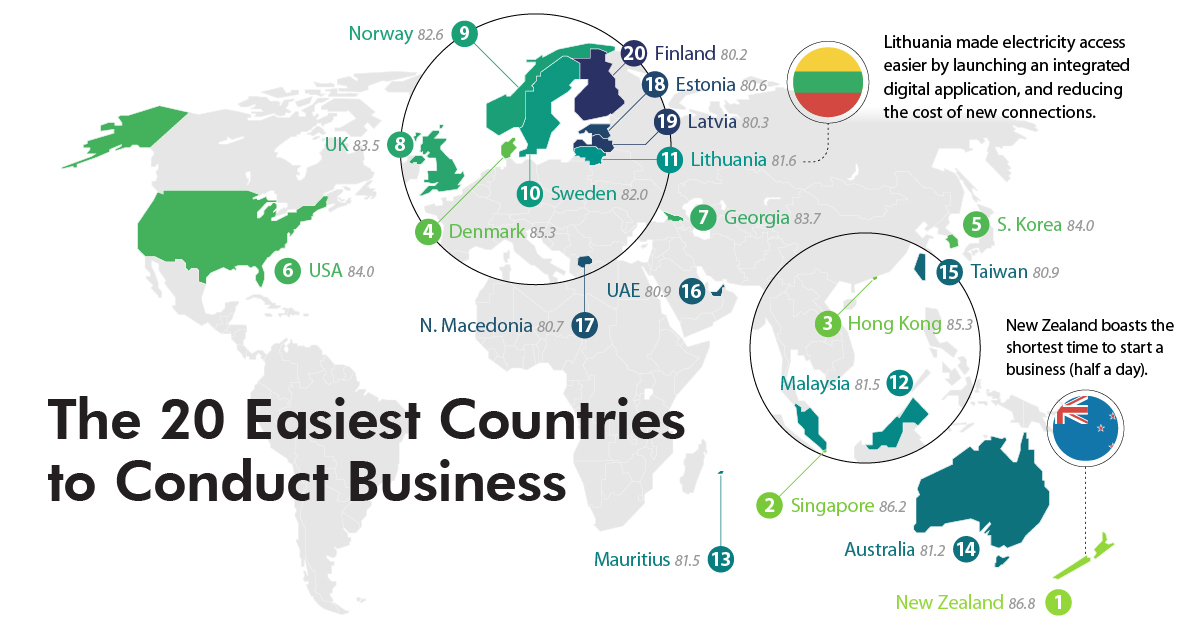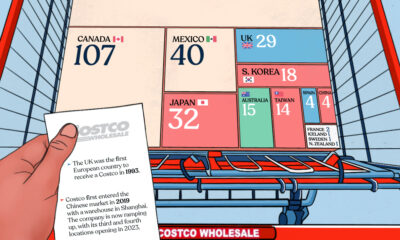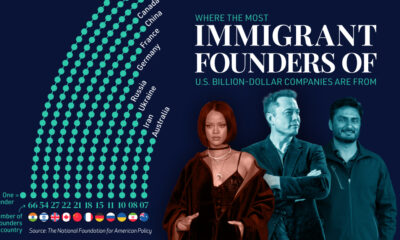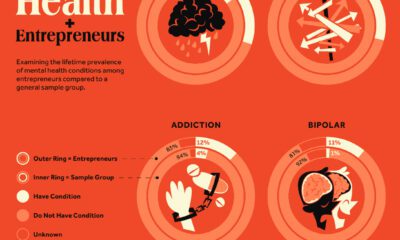Business
Ranked: The 20 Easiest Countries for Doing Business
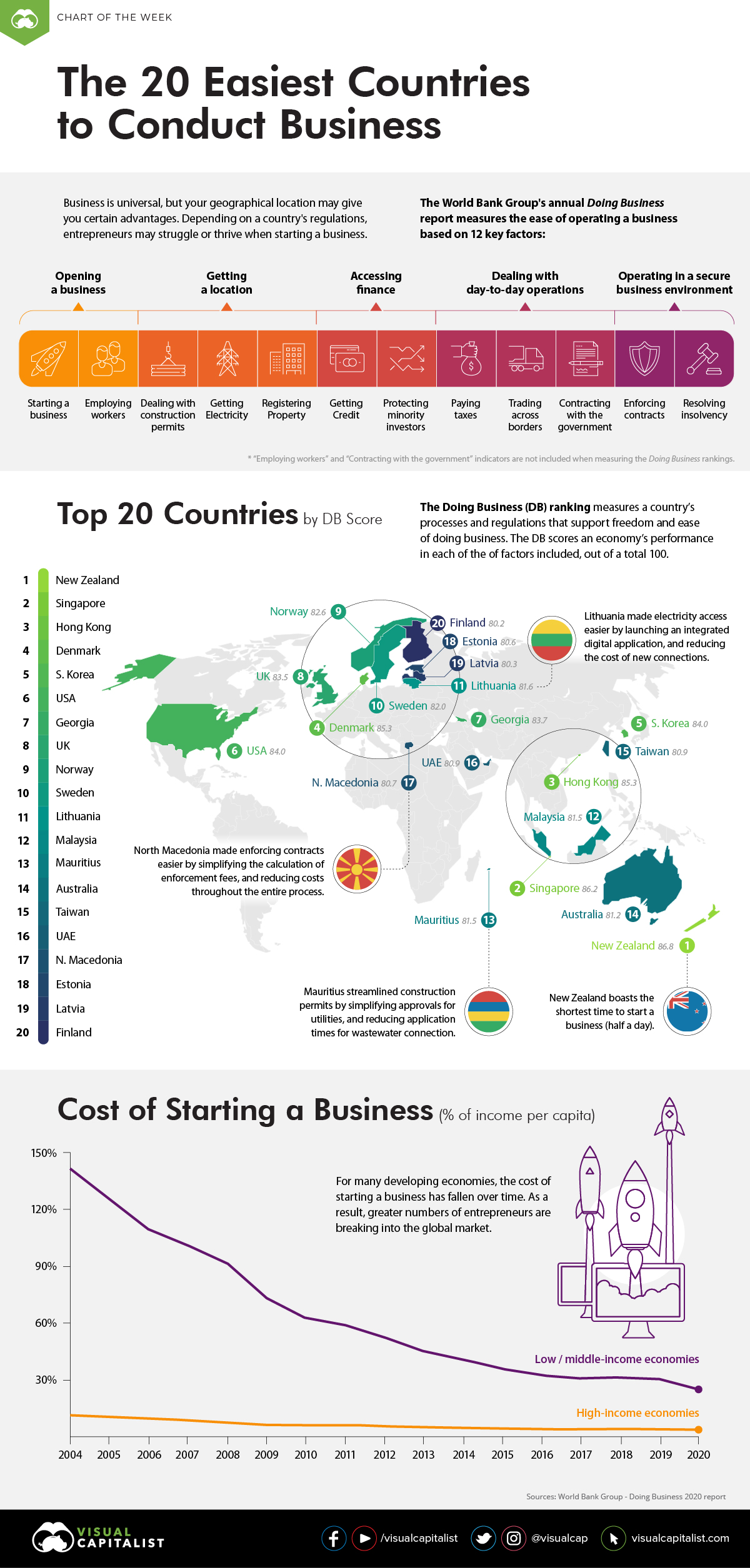
Ranked: The 20 Easiest Countries for Doing Business
Contrary to popular belief, the hardest part about running a business may not be finding customers, it’s getting one started.
Depending on the public policies and application processes of your country, you might struggle or succeed in opening and operating a business.
If you live in New Zealand, for example, you can get a new enterprise up and running in half a day. If you live in Luxembourg or Argentina, however, it’s a different story─with the process sometimes taking over a year.
Today’s chart uses data from the World Bank’s annual Doing Business 2020 report, which delves into the ease of doing business in countries around the world.
Measuring the Ease of Doing Business
Now in its 17th year, the Doing Business (DB) report measures how easy it is for someone to start and run a company in an economy, using 12 key factors throughout a business lifecycle:
- Starting a business
- Employing workers
- Dealing with construction permits
- Getting electricity
- Registering property
- Getting credit
- Protecting minority investors
- Paying taxes
- Trading across borders
- Contracting with the government
- Enforcing contracts
- Resolving insolvency
Of the 190 countries reviewed last year, only 115 made it easier for entrepreneurs to do business.
Note to readers: this year’s DB score did not factor in Employing Workers or Contracting with the Government when ranking economies.
Top 20 Easiest Countries to Run a Business
| Rank | Country | DB Score |
|---|---|---|
| #1 | 🇳🇿 New Zealand | 86.8 |
| #2 | 🇸🇬 Singapore | 86.2 |
| #3 | 🇭🇰 Hong Kong | 85.3 |
| #4 | 🇩🇰 Denmark | 85.3 |
| #5 | 🇰🇷 South Korea | 84 |
| #6 | 🇺🇸 United States | 84 |
| #7 | 🇬🇪 Georgia | 83.7 |
| #8 | 🇬🇧 United Kingdom | 83.5 |
| #9 | 🇳🇴 Norway | 82.6 |
| #10 | 🇸🇪 Sweden | 82 |
| #11 | 🇱🇹 Lithuania | 81.6 |
| #12 | 🇲🇾 Malaysia | 81.5 |
| #13 | 🇲🇺 Mauritius | 81.5 |
| #14 | 🇦🇺 Australia | 81.2 |
| #15 | 🇹🇼 Taiwan | 80.9 |
| #16 | 🇦🇪 United Arab Emirates | 80.9 |
| #17 | 🇲🇰 North Macedonia | 80.7 |
| #18 | 🇪🇪 Estonia | 80.6 |
| #19 | 🇱🇻 Latvia | 80.3 |
| #20 | 🇫🇮 Finland | 80.2 |
In the top spot for the fourth year in a row, New Zealand only requires half a day to start a business. Singapore also stands out for having the shortest timeframe when it comes to paying business taxes and enforcing business contracts.
Only two African nations─Rwanda and Mauritius─are listed in the top 50 countries, with Mauritius being the only one to crack the top 20 list.
Latin American economies are noticeably missing from the rankings, as many countries in this region are fraught with bureaucracy and prolonged processes.
Most Improved Scores
Several developed and developing economies made significant strides in 2019 to implement reforms that opened doors for new business owners.
The Doing Business 2020 report shows that the cost of starting a business has fallen over time, particularly in developing economies.
Top 10 Most Improved Economies, 2018-2019
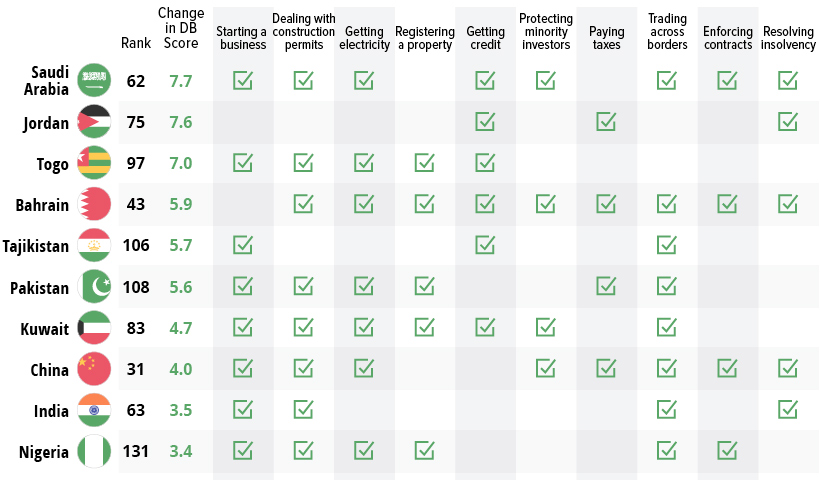
Saudi Arabia made the greatest improvement overall, adding 7.7 points to its score.
Bahrain also made improvements over the most number of factors (9). While Jordan showed improvement in the fewest factors (3), it showed the second highest jump in DB Score.
Gains Among Low-Income Countries
The DB 2020 study also shows that developing economies are making progress: it’s now cheaper than ever before to run a business in developing economies.
However, a significant disparity still remains when we consider the difference in business costs between high-income and low-income economies.
An entrepreneur starting a company in a low-income economy will spend about 50% of per capita income (PCI) to launch a venture, whereas an entrepreneur in a high-income economy spends only 4% PCI to accomplish the same task.
Put another way, entrepreneurs located in the bottom 50 economies spend an average six times more to open a new company as those in a high-income economy.
Entrepreneurship and Economic Growth
Generally, more entrepreneurs will enter a market where they can easily conduct business─adding more value to local economies.
While the rankings clearly illustrate the link between ease of doing business and economic growth, there are still significant barriers in place that not only deter entrepreneurship but also inhibit a relatively simple strategy for growth.
Technology
How Tech Logos Have Evolved Over Time
From complete overhauls to more subtle tweaks, these tech logos have had quite a journey. Featuring: Google, Apple, and more.

How Tech Logos Have Evolved Over Time
This was originally posted on our Voronoi app. Download the app for free on iOS or Android and discover incredible data-driven charts from a variety of trusted sources.
One would be hard-pressed to find a company that has never changed its logo. Granted, some brands—like Rolex, IBM, and Coca-Cola—tend to just have more minimalistic updates. But other companies undergo an entire identity change, thus necessitating a full overhaul.
In this graphic, we visualized the evolution of prominent tech companies’ logos over time. All of these brands ranked highly in a Q1 2024 YouGov study of America’s most famous tech brands. The logo changes are sourced from 1000logos.net.
How Many Times Has Google Changed Its Logo?
Google and Facebook share a 98% fame rating according to YouGov. But while Facebook’s rise was captured in The Social Network (2010), Google’s history tends to be a little less lionized in popular culture.
For example, Google was initially called “Backrub” because it analyzed “back links” to understand how important a website was. Since its founding, Google has undergone eight logo changes, finally settling on its current one in 2015.
| Company | Number of Logo Changes |
|---|---|
| 8 | |
| HP | 8 |
| Amazon | 6 |
| Microsoft | 6 |
| Samsung | 6 |
| Apple | 5* |
Note: *Includes color changes. Source: 1000Logos.net
Another fun origin story is Microsoft, which started off as Traf-O-Data, a traffic counter reading company that generated reports for traffic engineers. By 1975, the company was renamed. But it wasn’t until 2012 that Microsoft put the iconic Windows logo—still the most popular desktop operating system—alongside its name.
And then there’s Samsung, which started as a grocery trading store in 1938. Its pivot to electronics started in the 1970s with black and white television sets. For 55 years, the company kept some form of stars from its first logo, until 1993, when the iconic encircled blue Samsung logo debuted.
Finally, Apple’s first logo in 1976 featured Isaac Newton reading under a tree—moments before an apple fell on his head. Two years later, the iconic bitten apple logo would be designed at Steve Jobs’ behest, and it would take another two decades for it to go monochrome.
-

 Markets1 week ago
Markets1 week agoU.S. Debt Interest Payments Reach $1 Trillion
-

 Markets2 weeks ago
Markets2 weeks agoRanked: The Most Valuable Housing Markets in America
-

 Money2 weeks ago
Money2 weeks agoWhich States Have the Highest Minimum Wage in America?
-

 AI2 weeks ago
AI2 weeks agoRanked: Semiconductor Companies by Industry Revenue Share
-

 Markets2 weeks ago
Markets2 weeks agoRanked: The World’s Top Flight Routes, by Revenue
-

 Countries2 weeks ago
Countries2 weeks agoPopulation Projections: The World’s 6 Largest Countries in 2075
-

 Markets2 weeks ago
Markets2 weeks agoThe Top 10 States by Real GDP Growth in 2023
-

 Money2 weeks ago
Money2 weeks agoThe Smallest Gender Wage Gaps in OECD Countries

